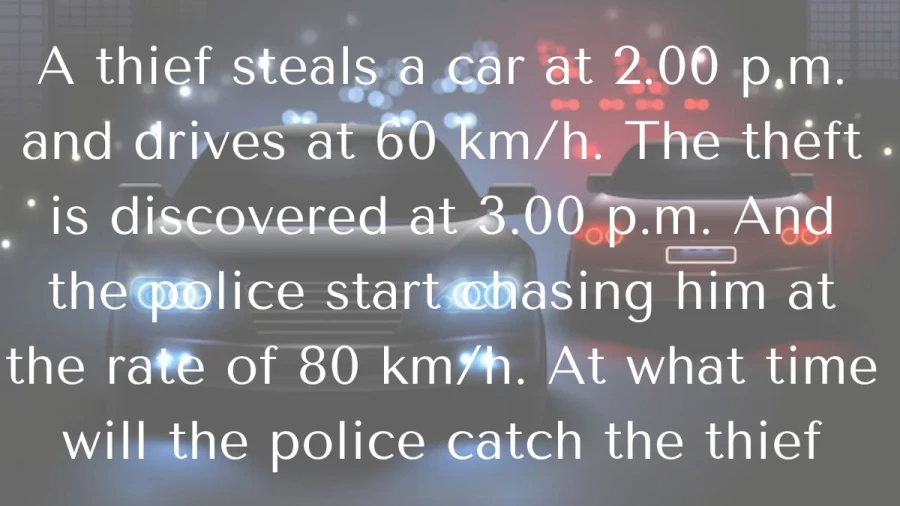If you happen to be viewing the article A thief steals a car at 2.00 p.m. and drives at 60 km/h. The theft is discovered at 3.00 p.m. And the police start chasing him at the rate of 80 km/h. At what time will the police catch the thief? ? on the website Math Hello Kitty, there are a couple of convenient ways for you to navigate through the content. You have the option to simply scroll down and leisurely read each section at your own pace. Alternatively, if you’re in a rush or looking for specific information, you can swiftly click on the table of contents provided. This will instantly direct you to the exact section that contains the information you need most urgently.
Find out what happens when the police chase down a car thief on the highway.
A thief steals a car at 2.00 p.m. and drives at 60 km/h. The theft is discovered at 3.00 p.m. And the police start chasing him at the rate of 80 km/h. At what time will the police catch the thief?
It will take the police 3 hours to catch the thief.
To solve this problem, we’ll first find out how far the thief has traveled by 3:00 p.m. when the theft is discovered, then calculate how long it takes for the police to catch up to him.
From 2:00 p.m. to 3:00 p.m., the thief travels for 1 hour at a speed of 60 km/h. So, the distance covered by the thief during this time is:
Distance = Speed × Time
Distance = 60 km/h × 1 hour
Distance = 60 km
Now, when the police start chasing him at 3:00 p.m., the thief has already traveled 60 km.
The relative speed of the police catching up to the thief is the difference between their speeds:
Relative speed = Police speed – Thief speed
Relative speed = 80 km/h – 60 km/h
Relative speed = 20 km/h
Now, we can calculate the time it takes for the police to catch the thief using the formula:
Time = Distance / Relative speed
Time = 60 km / 20 km/h
Time = 3 hours
So, it will take the police 3 hours to catch the thief.
Since the police start chasing at 3:00 p.m., they will catch the thief at 6:00 p.m.
Distance, Time and Speed in Mathematics
In mathematics, distance, time, and speed are interconnected concepts often studied within the realm of kinematics, a branch of classical mechanics that describes the motion of objects without considering the forces causing the motion. Here’s a brief overview of each concept:
-
Distance: Distance refers to the length of the path traveled by an object. It is a scalar quantity, meaning it only has magnitude and no direction. Distance is typically measured in units such as meters (m), kilometers (km), miles (mi), etc.
-
Time: Time is the duration between two events. In the context of motion, it is the duration taken by an object to travel from one point to another. Time is also a scalar quantity, measured in units such as seconds (s), minutes (min), hours (hr), etc.
-
Speed: Speed is the rate at which an object covers distance. It is a measure of how fast something is moving. Speed is a scalar quantity and is defined as the distance traveled per unit of time. Mathematically, speed is calculated as:
Speed = Distance / Time
Speed can be further categorized into average speed and instantaneous speed. Average speed is the total distance traveled divided by the total time taken, while instantaneous speed is the speed of an object at a particular instant in time.
These concepts are often used in various real-life applications, such as calculating travel times, designing transportation systems, analyzing sports performances, and understanding motion in physics. Additionally, these concepts serve as fundamental building blocks for more advanced topics in physics and mathematics, such as velocity, acceleration, and calculus-based kinematics.
Thank you so much for taking the time to read the article titled A thief steals a car at 2.00 p.m. and drives at 60 km/h. The theft is discovered at 3.00 p.m. And the police start chasing him at the rate of 80 km/h. At what time will the police catch the thief? written by Math Hello Kitty. Your support means a lot to us! We are glad that you found this article useful. If you have any feedback or thoughts, we would love to hear from you. Don’t forget to leave a comment and review on our website to help introduce it to others. Once again, we sincerely appreciate your support and thank you for being a valued reader!
Source: Math Hello Kitty
Categories: Math

